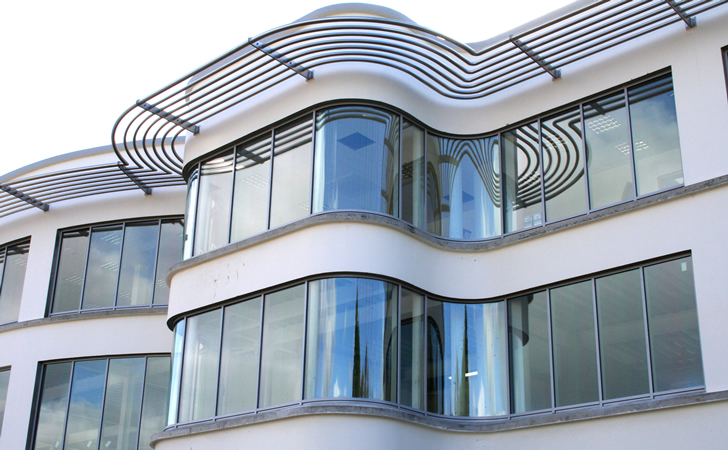Curved glass
Curved glass is commonly used as an element of façades and interiors in modernist designs for commercial and residential buildings. It often specified in designs as a feature element because of its uniqueness.
Technological advances in recent decades, such as robotic and automated manufacturing, have meant that curved glass has become easier and cheaper to produce and can be used to tighter radii, greater girths and greater overall dimensions.However, is not available in standard sizes so each building will require custom-made production.
Depending on the design requirements, there are a number of different forms in which curved glass can be used:
- Curved annealed glass: This is often used for showcasing purposes where there is less necessity for strength and safety, such as shop windows.
- Curved toughened glass: This is strong and shock-resistant, produced by heating annealed glass to 700°C and then cooling it rapidly. It is commonly used in staircases and for other interior purposes.
- Laminated glass: This is formed by bonding two layers of glass and is very tough. When it shatters it stays within the lamination, rather than breaking into shards.
Clearly communicating the requirements, criteria and expected standards early in the deign process can be important as then, all parties – glazing manufacturer, façade contractor, architect, client, and so on – can fully understand the implications of the requirement prior to manufacture.
The relevant standards for cylindrical bent float glass are BS ISO 11485 Part 2 (2012), and the American ASTM C 1464-06 (reapproved 2011).
[edit] Related articles on Designing Buildings Wiki
Featured articles and news
The UK's Modern Industrial Strategy: A 10 year plan
Previous consultation criticism, current key elements and general support with some persisting reservations.
Building Safety Regulator reforms
New roles, new staff and a new fast track service pave the way for a single construction regulator.
Architectural Technologist CPDs and Communications
CIAT CPD… and how you can do it!
Cooling centres and cool spaces
Managing extreme heat in cities by directing the public to places for heat stress relief and water sources.
Winter gardens: A brief history and warm variations
Extending the season with glass in different forms and terms.
Restoring Great Yarmouth's Winter Gardens
Transforming one of the least sustainable constructions imaginable.
Construction Skills Mission Board launch sector drive
Newly formed government and industry collaboration set strategy for recruiting an additional 100,000 construction workers a year.
New Architects Code comes into effect in September 2025
ARB Architects Code of Conduct and Practice available with ongoing consultation regarding guidance.
Welsh Skills Body (Medr) launches ambitious plan
The new skills body brings together funding and regulation of tertiary education and research for the devolved nation.
Paul Gandy FCIOB announced as next CIOB President
Former Tilbury Douglas CEO takes helm.
UK Infrastructure: A 10 Year Strategy. In brief with reactions
With the National Infrastructure and Service Transformation Authority (NISTA).
Ebenezer Howard: inventor of the garden city. Book review.
The Grenfell Tower fire, eight years on
A time to pause and reflect as Dubai tower block fire reported just before anniversary.
Airtightness Topic Guide BSRIA TG 27/2025
Explaining the basics of airtightness, what it is, why it's important, when it's required and how it's carried out.
Construction contract awards hit lowest point of 2025
Plummeting for second consecutive month, intensifying concerns for housing and infrastructure goals.
Understanding Mental Health in the Built Environment 2025
Examining the state of mental health in construction, shedding light on levels of stress, anxiety and depression.






















